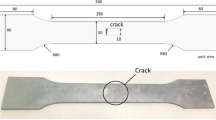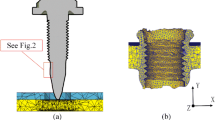Abstract
The corrosion of voided tendons has been a long-standing issue in Post-Tensioned (PT) systems because it can lead to the failure of tendons and deteriorate bridge performance. Repair grouting in voided tendons can be one of many rehabilitation options if there are no galvanic couples between the new grouts and original grouts. To identify an appropriate repair grouting method for voided tendons, numerical analysis using a commercial Computational Fluid Dynamics (CFD) program, FLUENT, is utilized in this research. The geometry of voided tendons is a complicating factor when creating reliable models for numerical analysis; thus, a research for the simulation of repair grout flow proposed a simplified model and verified the model with experimental results. Thus, this research performs numerical analyses using the simplified model and assesses various parameters of repair methods and materials. The numerical results indicate that the Pressure-Vacuum Grouting (PVG) method with repair grouts having low viscosity exhibits the best performance for filling voids. If it is determined that filling voids with repair grout is appropriate and prevents future corrosion, it is recommended that voids in the field be filled using the PVG method with grouts exhibiting low viscosities.
Similar content being viewed by others
References
Armaly, B. F., Durst, F., Pereira, J. C. F., and Schonung, B. (1983). “Experimental and theoretical investigation of backward-facing step flow.” Journal of Fluid Mechanics, Vol. 127, pp. 473–496.
Banerjee, R. and Isaac, K. M. (2006). “A study to determine vapor generation from the surface of gasoline flowing in an inclined channel using a continuous thermodynamics approach.” Numerical Heat Transfer, Part A, Vol. 50, pp. 705–729.
Banerjee, R., Isaac, K. M., Oliver, L., and Breig, W. (2002). “Features of automotive gas tank filler pipe two-phase flow: Experiments and computational fluid dynamics simulations.” Journal of Engineering for Gas Turbines and Power, Vol. 124, pp. 412–420.
Corven, J. A. (2001). Mid-Bay bridge post-tensioning evaluation — final report, Florida Department of Transportation (FDOT), Corven Engineering, Inc, Tallahassee, FL.
Ekambara, K., Sanders, R. S., Nandakumar, K., and Masliyah, J. H. (2008). “CFD simulation of bubbly two-phase flow in horizontal pipes.” Chemical Engineering Journal, Vol. 144, pp. 277–288.
FLUENT (2006). Introductory FLUENT notes. Ansys Inc., <http://www.fluentusers.com> (Jan. 14, 2010).
Im, S. B. and Hurlebaus, S. (2010). “Modeling and validation of repair grout flow in voided ducts.” ACI Structural Journal, submitted 2010.
Im, S. B., Hurlebaus, S., and Trejo, D. (2010). “Effective repair grouting methods and materials for filling voids in external post-tensioned tendons.” Transportation Research Record: Journal of Transportation Research Board, No. 2172, pp. 3–10.
Kataria, S. (2008). Assessment of grouts for constructability and durability of post-tensioned bridges, MS Thesis, Texas A&M University, College Station, TX.
Kim, M. and Corapcioglu, M. Y. (2002) “Cel barrier formation in unsaturated porous media.” Journal of Contaminant Hydrology, Vol. 56, pp. 75–98.
Lima, R. C., Andrade, C. R., and Zaparoli, E. L. (2008). “Numerical study of three recirculation zones in the unilateral sudden expansion flow.” International Communications in Heat and Mass Transfer, Vol. 35, pp. 1053–1060.
Ndinisa, N. V., Wiley, D. E., and Fletcher, D. F. (2005). “Computational fluid dynamics simulations of Taylor bubbles in tubular membranes model validation and application to laminar flow systems.” Chemical Engineering Research and Design, Vol. 83, No. A1, pp. 40–49.
Pearson-Kirk, D. (2003). “The performance of post-tensioned bridge.” Role of Concrete Bridges in Sustainable Development — Proceedings of International Symposium, pp. 129–140.
Pielstick, B. (2002). “Grouting of segmental posttensioned bridges in America.” Transportation Research Record: Journal of Transportation Research Board, No. 1813, pp. 235–241.
Ragab, A., Brandstaetter, W., and Shalaby, S. (2008). “Numerical simulation of slug flow phenomena in horizontal and inclined pipelines.” Oil Gas European Magazine, Vol. 34, pp. 194–199.
Raiss, M. (1995). “Post-tensioned concrete bridges: The UK debate.” Concrete International, Vol. 29, No. 2, pp. 23–26.
Sampaio, P. A. B., Faccini, J. L. H., and Su, J. (2008). “Modelling of stratified gas-liquid two-phase flow in horizontal circular pipes.” International Journal of Heat and Mass Transfer, Vol. 51, pp. 2752–2761.
Schokker, A. J., Breen, J. E., and Kreger, M. E. (2001). “Grouts for bonded post-tensioning in corrosive environments.” ACI Materials Journal, Vol. 98, No. 4, pp. 296–305.
Shao, N., Salman, W., Gavriilidis, A., and Angeli, P. (2008). “CFD simulations of the effect of inlet conditions on Taylor flow formation.” International Journal of Heat and Fluid Flow, Vol. 29, pp. 1603–1611.
Sprinkel, M. and Napier, C. S. (2008). “VDOT experience with grouted tendons in Varina-Enon precast segmental post-tensioned bridge.” Virginia Concrete Conference, March 7, 2008, Virginia, USA.
Taha, T. and Cui, Z. F. (2002). “CFD modelling of gas-sparged ultrafiltration in tubular membranes.” Journal of Membrane, Vol. 210, pp. 13–27.
Xiong, R., Bai, M., and Chung, J. N. (2007). “Formation of bubbles in a simple co-flowing micro-channel.” Journal of Micromechanics and Microengineering, Vol. 17, pp. 1002–1011.
Author information
Authors and Affiliations
Corresponding author
Rights and permissions
About this article
Cite this article
Im, S.B., Hurlebaus, S. Simulation of repair grout flow in external tendon system. KSCE J Civ Eng 16, 1250–1257 (2012). https://doi.org/10.1007/s12205-012-1642-1
Received:
Revised:
Accepted:
Published:
Issue Date:
DOI: https://doi.org/10.1007/s12205-012-1642-1




